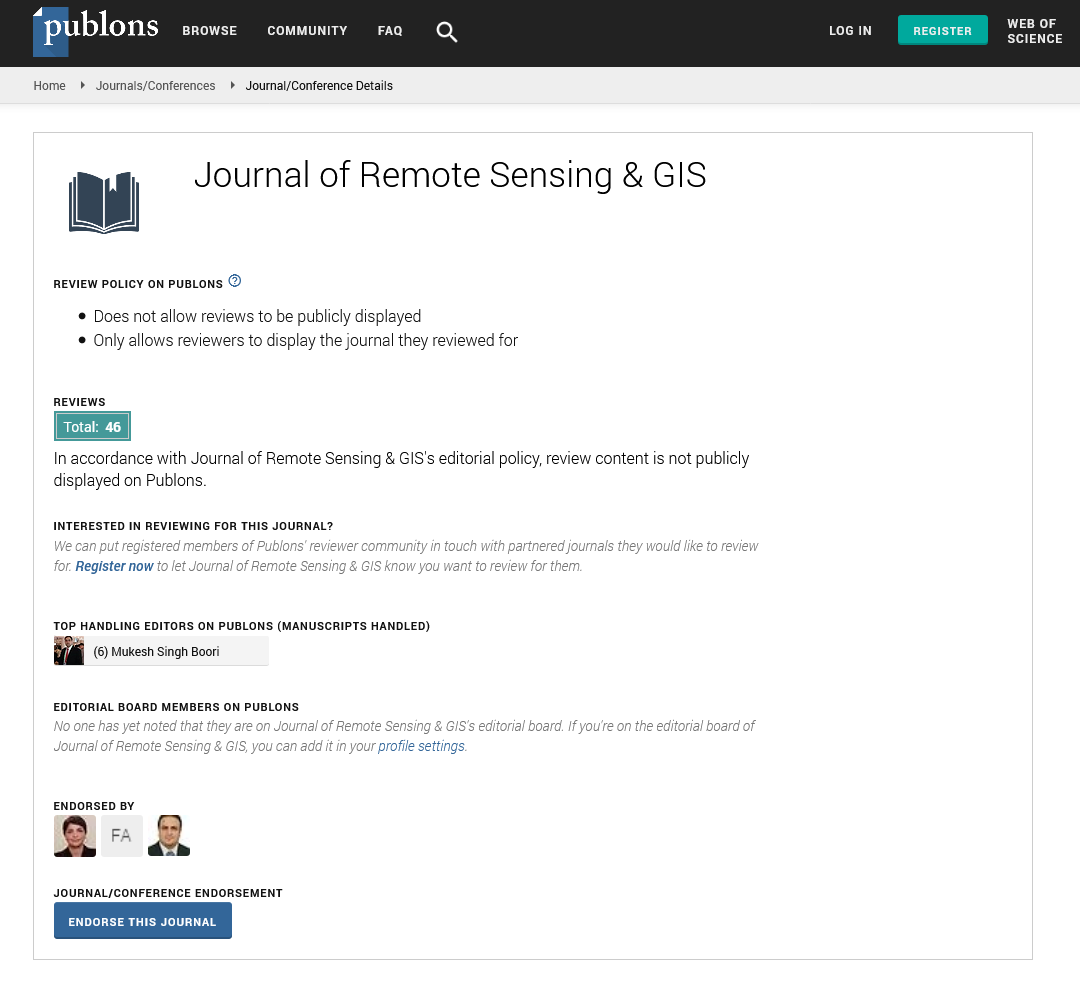Indexed In
- Open J Gate
- RefSeek
- Hamdard University
- EBSCO A-Z
- OCLC- WorldCat
- Publons
- International Scientific Indexing
- Euro Pub
- Google Scholar
Useful Links
Share This Page
Journal Flyer

Open Access Journals
- Agri and Aquaculture
- Biochemistry
- Bioinformatics & Systems Biology
- Business & Management
- Chemistry
- Clinical Sciences
- Engineering
- Food & Nutrition
- General Science
- Genetics & Molecular Biology
- Immunology & Microbiology
- Medical Sciences
- Neuroscience & Psychology
- Nursing & Health Care
- Pharmaceutical Sciences
Perspective - (2024) Volume 13, Issue 1
Geointelligence in Earth Observation and Remote Sensing Using Geoinformatics
Huang Le*Received: 01-Mar-2024, Manuscript No. JGRS-24-24598; Editor assigned: 04-Mar-2024, Pre QC No. JGRS-24-24598 (PQ); Reviewed: 18-Mar-2024, QC No. JGRS-24-24598; Revised: 25-Mar-2024, Manuscript No. JGRS-24-24598 (R); Published: 01-Apr-2024, DOI: 10.35248/2469-4134.24.13.335
Description
Landscape of Earth observation and spatial analysis, the convergence of advanced remote sensing technologies with the power of geoinformatics has given rise to a new era of Geo- Intelligence. This transformative synergy integrates cutting-edge sensing capabilities with sophisticated spatial information systems, insights into the Earth's surface its dynamics and the complex interplay of environmental processes. Geo-Intelligence stands at the forefront of scientific discovery, resource management, disaster response, and strategic decision-making, offering a holistic approach to understanding and harnessing the wealth of spatial data. Geo-Intelligence tackle the capabilities of advanced remote sensing technologies to acquire data about the Earth's surface from a distance. Satellites equipped with multispectral, hyperspectral, and synthetic aperture radar sensors capture a wealth of information, including visible and infrared imagery, thermal radiation, and microwave signals. These technologies enable scientists to peer beyond the visible spectrum, unveiling hidden patterns, detecting subtle changes, and providing critical data for a myriad of applications. The fusion of remote sensing with geoinformatics amplifies the impact of Geo-Intelligence. Geoinformatics, an interdisciplinary field that encompasses Geographic Information Systems (GIS), spatial analysis, and cartography, acts as the intelligence hub, where raw remote sensing data transforms into actionable insights. GIS platforms serve as the digital backbone, providing a spatial context for the diverse data layers derived from remote sensing, allowing for seamless integration, analysis, and visualization.
Geo-Intelligence lies in its application to environmental monitoring and management. Remote sensing satellites equipped with advanced sensors capture detailed information about the Earth's land cover, vegetation health, and changes in surface temperature. Geoinformatics tools then process this data, creating dynamic maps that facilitate the monitoring of deforestation, land degradation, and biodiversity loss. This integrated approach supports informed decision-making for sustainable resource management and conservation efforts. In agriculture, Geo-Intelligence plays a pivotal role in the era of precision farming. Remote sensing technologies, such as Unmanned Aerial Vehicles (UAVs) and satellites, equipped with high-resolution sensors, capture detailed images of agricultural landscapes. Geoinformatics applications process this imagery to generate maps highlighting variations in soil moisture, nutrient levels, and crop health. Farmers can use these maps to optimize irrigation, fertilizer application, and pest control, leading to increased efficiency, reduced environmental impact, and improved crop yields.
Geo-Intelligence also contributes significantly to disaster management and response. In the aftermath of natural disasters such as hurricanes, earthquakes, or floods, remote sensing technologies provide actual imagery for damage assessment. Geoinformatics tools facilitate the creation of detailed impact maps, aiding in the identification of affected areas, assessment of infrastructure damage, and planning of relief efforts. The integration of spatial data enhances the speed and accuracy of decision-making during critical phases of disaster response. Urban planning and development benefit immensely from the capabilities of Geo-Intelligence. Remote sensing satellites capture high-resolution imagery of urban areas, documenting changes in land use, infrastructure development, and population growth. Geoinformatics tools process this data to create urban heat maps, assess transportation patterns, and model future development scenarios. Planners can leverage this intelligence to make informed decisions about sustainable urban growth, infrastructure investments, and disaster resilience. The application of Geo-Intelligence extends to national security and defense. Satellite-based remote sensing provides critical information for monitoring geopolitical developments, tracking the movement of military assets, and assessing environmental changes that may impact strategic interests. Geoinformatics facilitates the integration of diverse spatial datasets, aiding in the analysis of complex geopolitical scenarios and supporting decision-making at various levels of command.
Advancements in Geo-Intelligence are closely tied to the ongoing evolution of remote sensing technologies. The launch of highresolution satellites, the development of novel sensor technologies, and the integration of machine learning algorithms for automated image analysis are pushing the boundaries to maximum achievable. In parallel, geoinformatics is advancing with improved data interoperability, cloud-based processing capabilities, and user-friendly interfaces that democratize access to spatial intelligence. The transformative potential of Geo-Intelligence, challenges persist. Ensuring data accuracy, addressing privacy concerns, and managing the vast volumes of spatial data generated by remote sensing satellites are ongoing considerations. Additionally, there is a need for continued collaboration between scientists, policymakers and technologists to harness the full potential of Geo-Intelligence in addressing global challenges. Advanced remote sensing technologies with the analytical expertise of geoinformatics are remodelling our ability to monitor, understand, and manage the complex interactions shaping our planet. From environmental conservation and precision agriculture to disaster response and national security Geo-Intelligence is proving to be a cornerstone of informed decision-making in an increasingly interconnected and spatially aware world. Geo-Intelligence promises to even greater insights into the intricate tapestry of the Earth's surface and the forces.
Citation: Le H (2024) Geointelligence in Earth Observation and Remote Sensing Using Geoinformatics. J Remote Sens GIS. 13.335.
Copyright: © 2024 Le H. This is an open-access article distributed under the terms of the Creative Commons Attribution License, which permits unrestricted use, distribution, and reproduction in any medium, provided the original author and source are credited.

